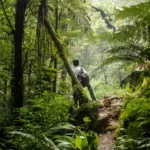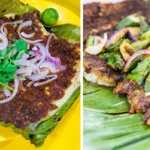Table of Contents
ToggleIntroduction
Sandakan, a coastal town in Sabah, Malaysia, is a destination filled with colonial charm, rich in multicultural history, and fascinating architecture. Sandakan was known as the former capital of British North Borneo. It is a place where time seems to stand still, especially when you walk its old streets.
One of the best ways to experience Sandakan’s heritage is through a self-guided walking tour of the Sandakan City Heritage Trail. This route takes you past some of the city’s most iconic buildings, temples, churches, and historical landmarks— all within comfortable walking distance from one another.
Whether you’re a solo traveler, history enthusiast, or slow-travel advocate, the Sandakan City Heritage Trail offers deep cultural insight without the need for a tour guide.
In this blog post, we’ll walk you through everything you need to know: what to see, how to plan your walk, the best time to go, and practical tips to make the most of your day in Sandakan.
Why Explore Sandakan on Foot?
What Is the Sandakan City Heritage Trail?
Developed in collaboration with historians, local government, and tourism authorities, the trail serves as an open-air museum, guiding visitors through architectural landmarks, sacred sites, and public memorials that tell the story of Sandakan’s past.
From the Gothic revival stonework of St. Michael’s Church to the intricate altars of the Sam Sing Kung Temple, the Sandakan Heritage Trail tells the story of a resilient city.
The beauty of the trail lies in its accessibility. You don’t need a guide or tour group to appreciate it. All you need is a map, a pair of comfortable shoes, and a sense of curiosity. Whether you choose to do the full loop or just a portion of it, this walk will give you a deeper appreciation of the people and stories that built Sandakan.

How to Use This Self-Guided Trail
The trail is mostly flat and walkable, with plenty of local cafés and convenience stores along the way for breaks or refreshments.
Stop 1: Jamik Mosque (Masjid Jamik Sandakan)
The Jamik Mosque is not only an architectural landmark, but also a reminder of the peaceful coexistence of cultures and religions in Sandakan.
- Striking golden domes and clean white exterior
- Spacious prayer halls with tranquil ambiance
- Garden areas ideal for resting or quiet reflection
- Non-Muslim visitors are welcome outside prayer times
- A meaningful and accessible trail starting point
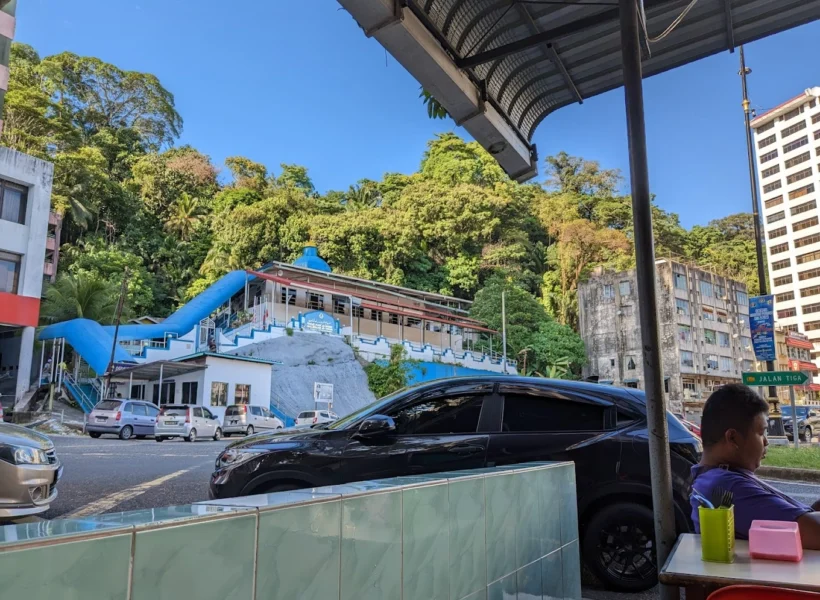
Stop 2: William Pryer Monument
Located in a shaded mini-park by the Sandakan waterfront, the William Pryer Monument honors the British officer who played a key role in founding modern-day Sandakan.
In the late 1800s, Pryer led efforts to develop Sandakan into the capital of British North Borneo, and his legacy can still be seen in the city’s colonial grid layout and early infrastructure.
While small in size, this monument is significant in context. It marks the early colonial influence that set the tone for Sandakan’s rapid growth during the British era. The surrounding green space provides a welcome break from the busier downtown streets and is often used by locals for mid-morning strolls or afternoon chats.
If you’re interested in colonial history, this stop will help set the scene for everything you’re about to explore.
- Tribute to William Pryer
- Peaceful waterfront mini-park with benches
- Introductory context for colonial-era Sandakan
- Great location for photos and orientation

Stop 3: 100 Steps Staircase
Nicknamed the “100 Steps”, this iconic staircase is a favorite among the Sandakan City Heritage Trail walkers alike. The staircase connects the lower city streets to the hilltop where colonial officials once lived— symbolically elevating you from the busy commercial center to a quieter, more reflective part of town.
- A short but invigorating climb
- Offers sweeping views over downtown Sandakan
- Lined with greenery and shaded areas
- Connects the lower city to colonial hilltop homes
- Excellent photography location
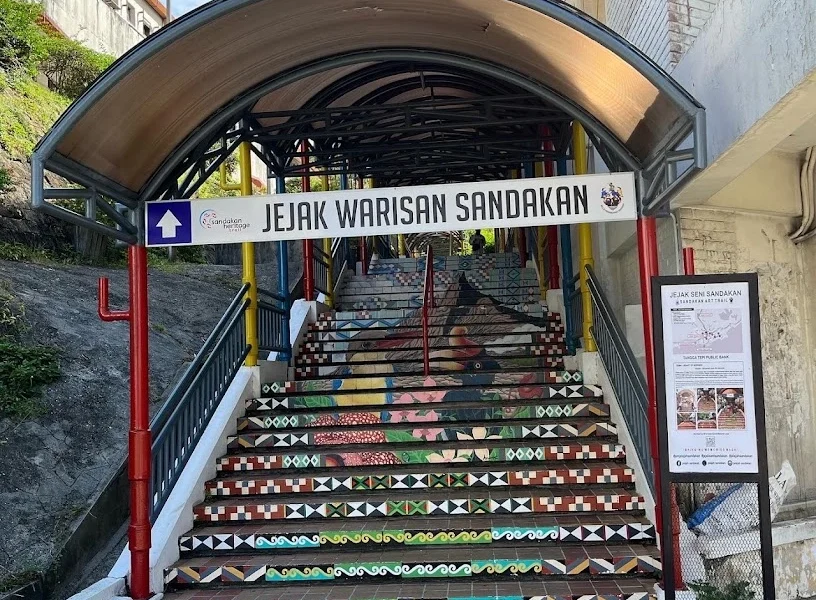
Stop 4: Agnes Keith House
The Agnes Keith House is one of Sandakan’s most treasured heritage buildings and a must-visit along the heritage trail. Once the home of American author Agnes Newton Keith and her husband Harry Keith, a British forest conservator, the house now operates as a museum that vividly recounts their lives in British North Borneo during the 1930s and 40s.
It’s also a favorite stop during the rainy season, offering visitors a cozy retreat where they can slow down, explore Sabah’s colonial past, and enjoy the warmth of storytelling and history.
Agnes became famous for her bestselling trilogy—including Three Came Home, which chronicles her harrowing experiences during the Japanese occupation and her time in internment camps. The house not only preserves architectural heritage but also honors her legacy as a storyteller who humanized life in Borneo for readers around the world.
- Personal story of author Agnes Keith
- Restored colonial-era furniture and décor
- Serene hilltop location with city views
- Great for literature and history buffs alike
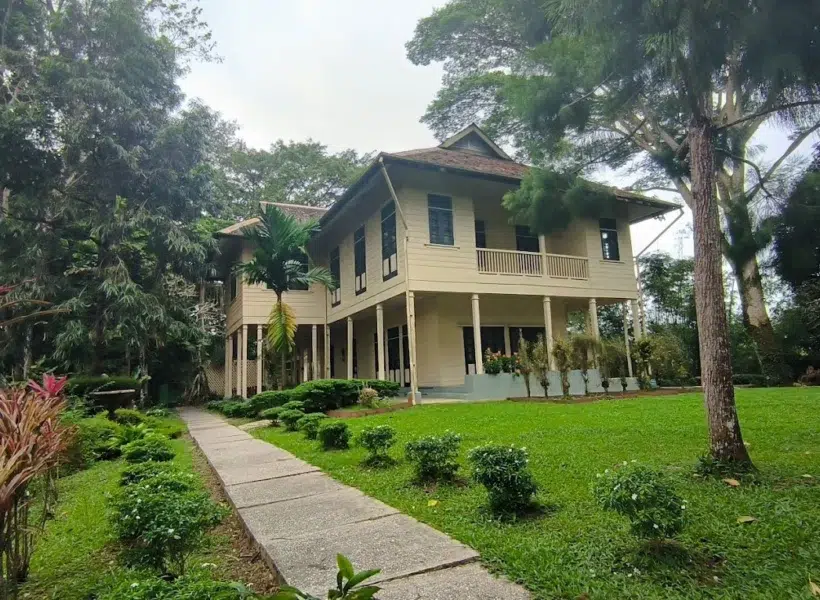
Stop 5: Remains of the Old Stairs
A short walk from Agnes Keith’s House will bring you to the Remains of the Old Stairs, a quiet and somewhat hidden relic of Sandakan’s colonial past.
These moss-covered stone steps are what’s left of a once-prominent staircase that led to government quarters and administrative buildings that no longer exist. Today, they stand as a subtle yet powerful reminder of how much was lost during the bombings of World War II.
While easy to overlook, these ruins add a thoughtful pause to the Sandakan City Heritage Trail. They represent resilience—how Sandakan rebuilt itself from near-total destruction after the war. Take a moment here to reflect on the city’s history of loss, survival, and transformation.
- Historical ruins representing lost colonial structures
- Symbol of Sandakan’s wartime destruction
- Photogenic stop for history lovers
- A meaningful and often missed part of the trail
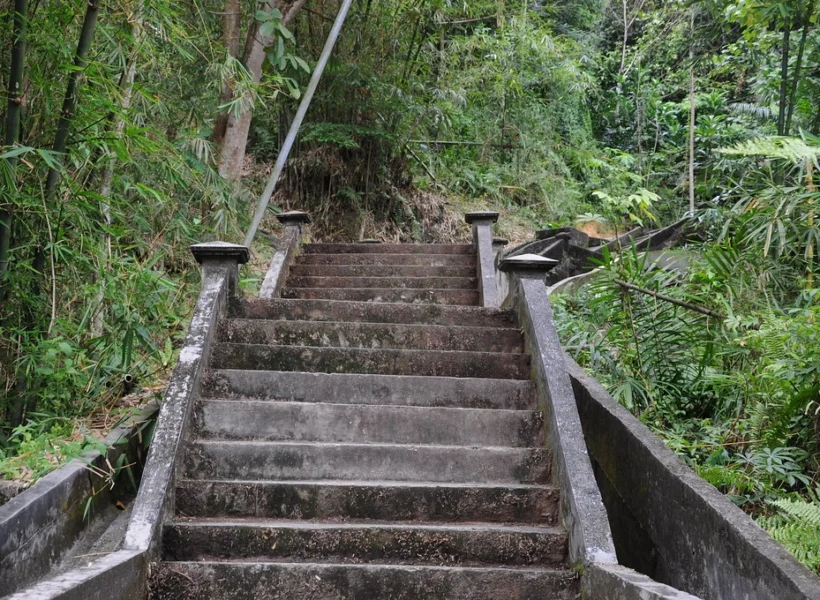
Stop 6: Goddess of Mercy Temple (Kuan Yin Temple)
The Goddess of Mercy Temple, also known as Kuan Yin Temple, is one of Sandakan’s oldest Chinese temples and is still actively used by worshippers today.
Tucked away on a peaceful side street, the temple is dedicated to the Buddhist deity Kuan Yin, who symbolizes compassion and mercy. Its red walls, ornate roof tiles, and hanging lanterns create a visually stunning space that invites both spiritual contemplation and cultural curiosity.
As you enter, the soft scent of incense fills the air, and offerings like fruit and candles adorn the altars. You’ll likely see devotees quietly praying or meditating, which adds to the temple’s serene ambiance. It’s a sacred space, so be respectful, observe silently, and enjoy a quiet moment of stillness during your walk.
- Temple dedicated to Kuan Yin, goddess of compassion
- Active place of worship with rituals and offerings
- Traditional Chinese temple design
- Peaceful and lesser-known spot on the trail
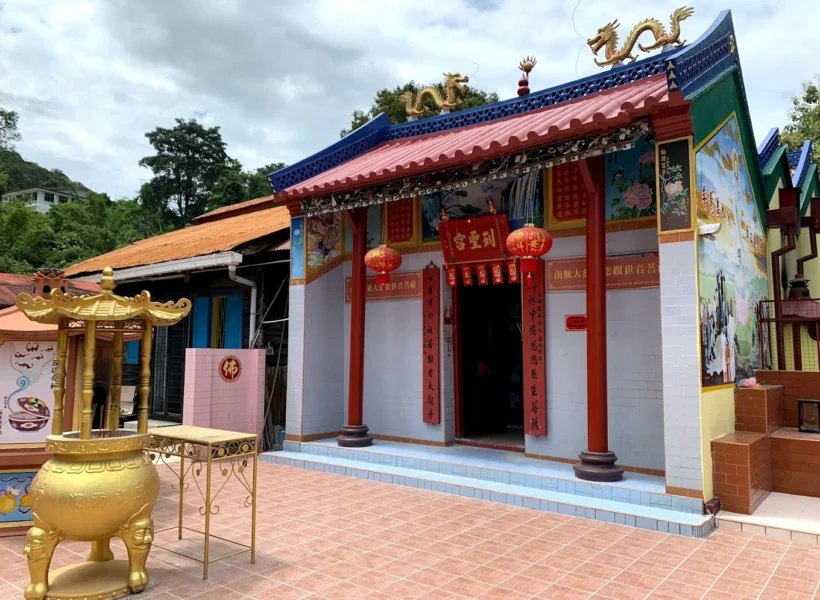
Stop 7: St. Michael’s and All Angels Church
St. Michael’s Church and All Angels Church is one of Sabah’s most iconic religious landmarks and a pillar of Sandakan’s Anglican community. Construction began in 1893, using locally quarried stone, and was completed decades later in 1925. Remarkably, it survived the heavy bombing of WWII and remains an enduring symbol of faith, endurance, and heritage.
- Gothic Revival design with historical stonework
- Survived WWII and still functions as a church
- Peaceful gardens with shaded seating
- Memorial stained-glass windows from Australia
- Essential stop on the heritage trail

Stop 8: Sam Sing Kung Temple
Dating back to 1887, Sam Sing Kung Temple is one of the oldest places of worship in Sandakan and it was dedicated to the “Three Saints”: Kwan Woon Cheung (God of Righteousness), Tin Hau (Goddess of the Sea), and Teck Kong (God of Prosperity). The temple was built by Chinese immigrants as a place for spiritual guidance and community.
Its beautiful structure includes curved tiled roofs, dragon carvings, and incense-filled halls. Local devotees still visit daily, and the temple is kept in immaculate condition. Adjacent to the temple is a small heritage building containing early records and artifacts related to the Chinese community in Sandakan.
- Oldest Taoist temple in Sandakan
- Dedicated to three revered deities
- Intricate carvings and architectural details
- Small heritage archive next door
- Active site for prayer and festivals
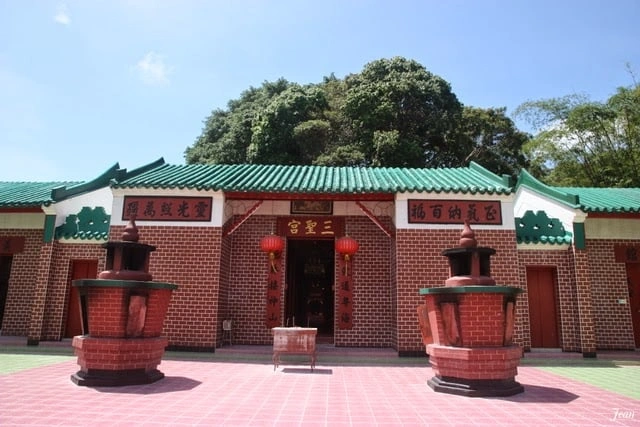
Stop 9: Malaysia Fountain
The Malaysia Fountain may be small, but it holds big symbolic meaning. Located in the center of a traffic circle near Wisma Warisan, the fountain commemorates the formation of Sabah into Malaysia as in 1963. It serves as a marker of national unity and Sandakan’s role in modern Malaysian history.
- Symbolic fountain celebrating Malaysia’s formation
- Central roundabout landmark
- Great photo stop between trail sections
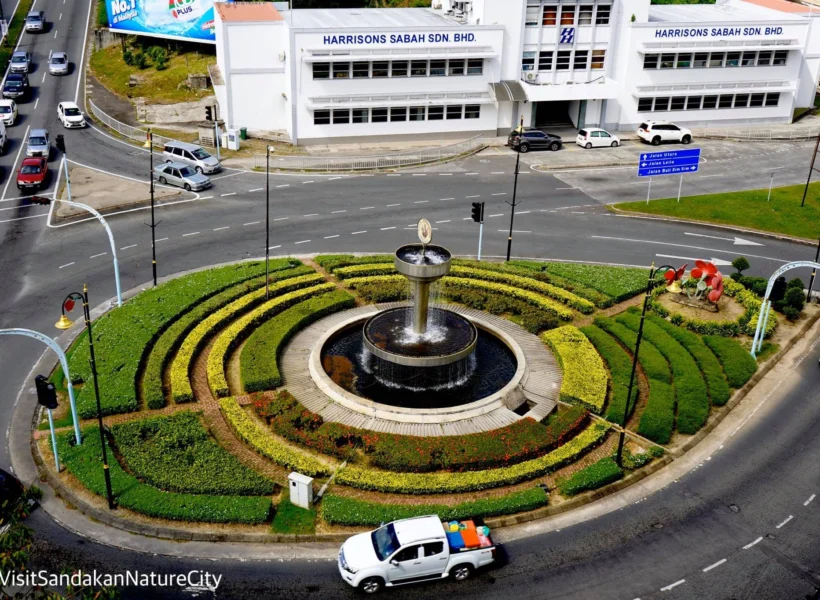
Stop 10: Wisma Warisan (Heritage Building)
Wisma Warisan, or the Sandakan Heritage Building, is both a heritage site and the home of the Sandakan Heritage Museum, making it a fitting end (or beginning) to the trail. Its classic colonial architecture, wide verandas, and open corridors reflect British-era design adapted for the tropical climate.
Inside, visitors will find exhibitions that chronicle Sandakan’s early settlers, the Japanese occupation, and post-independence growth. It’s the best place to tie together everything you’ve seen along the heritage trail and perhaps pick up some local brochures or books to deepen your knowledge.
The museum is also a great stop for families, offering an educational and engaging way for children and adults alike to learn about Sandakan’s rich history through interactive displays and storytelling.
- Classic colonial-style government building
- Home to Sandakan Heritage Museum
- Exhibits on early Sandakan and WWII history
- Ideal start or finish point for the trail

Explore with Ease: Sandakan City Heritage Trail Walking Map
Best Time to Visit & What to Bring
- March to October (dry season) is ideal.
- November to February is rainy but walkable.
- Breathable clothing
- Walking shoes
- Hat/umbrella
- Insect repellent
- Water bottle
- Smartphone or map
Tips for a Safe & Enjoyable Sandakan City Heritage Trail
- Walk early or late to avoid heat
- Respect dress codes for religious sites
- Bring cash for entrance fees or snacks
- Use offline maps in case of spotty signal
- Talk to locals—they’re often happy to help!
Final Thoughts
The Sandakan City Heritage Trail offers far more than a checklist of monuments or a series of Instagrammable backdrops. It is, in many ways, a walking narrative, one that invites you to immerse yourself in the living, breathing story of a city that has endured colonization, war, cultural shifts, and rebirth.
As you pass from one landmark to another, the layers of Sandakan’s identity begin to reveal themselves: the influences of the British North Borneo Company, the spiritual devotion of early Chinese immigrants, the endurance of communities through the Japanese occupation, and the quiet strength of a city that has rebuilt itself from near ruin.
Whether you begin at the Jamik Mosque or end at the Wisma Warisan, each moment along the Sandakan City Heritage Trail becomes a thread in the story you carry forward, one that connects you more deeply to the land, its people, and its past.
To explore more about Sandakan’s culture, history, and top attractions, check out our Ultimate Sandakan Travel Guide, your essential companion to uncovering Borneo’s most soulful city.
FAQs: The Sandakan City Heritage Trail
How long does it take to walk the Sandakan City Heritage Trail?
1.5 to 3 hours depending on your pace.
Is it child or senior-friendly?
Yes. Mostly flat route and accessible.
Do I need a guide to walk the Sandakan City Heritage Trail?
No. It’s self-guided and simple to follow.
Can I do the walk in the afternoon?
Yes, but avoid 12–2 p.m. due to heat.
Discover Sandakan with Milas Travel & Tour
At Milas Travel & Tour, we are your local companion in uncovering Sandakan’s hidden gems.
From the wildlife-rich Kinabatangan River and Sepilok Orangutan Centre to the historic Sandakan Heritage Trail, our team curates personalized tours that let you experience the best of nature, culture, and history — all without the hassle.
Regardless of whether you’re a family seeking a relaxing getaway, a nature enthusiast eager for close wildlife encounters, or a photographer chasing Sandakan’s most scenic views, we offer a range of thoughtfully designed packages to suit your travel style.
➜Contact us today to learn more or explore other tour packages that match your travel style!


